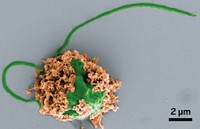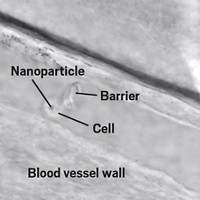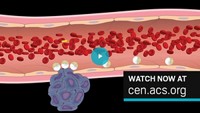Advertisement
Grab your lab coat. Let's get started
Welcome!
Welcome!
Create an account below to get 6 C&EN articles per month, receive newsletters and more - all free.
It seems this is your first time logging in online. Please enter the following information to continue.
As an ACS member you automatically get access to this site. All we need is few more details to create your reading experience.
Not you? Sign in with a different account.
Not you? Sign in with a different account.
ERROR 1
ERROR 1
ERROR 2
ERROR 2
ERROR 2
ERROR 2
ERROR 2
Password and Confirm password must match.
If you have an ACS member number, please enter it here so we can link this account to your membership. (optional)
ERROR 2
ACS values your privacy. By submitting your information, you are gaining access to C&EN and subscribing to our weekly newsletter. We use the information you provide to make your reading experience better, and we will never sell your data to third party members.
Biological Chemistry
Using nature’s motors to deliver drugs
Bacteria and sperm have natural advantages over synthetic nanomotors when navigating the body’s byways
by XiaoZhi Lim, special to C&EN
February 19, 2018
| A version of this story appeared in
Volume 96, Issue 8

Finding ways to deliver drugs to specific, hard-to-reach areas of the human body remains a major challenge in drug development. Drug molecules that enter the body via a pill or an injection circulate in the blood until they reach the target location—a process that can be slow and imprecise.
For years, many chemists have been building synthetic nanomotors—nanoparticles that propel themselves—to navigate the vessel-based highways of the body and drop off drugs in specific locations. But these artificial motors typically need fuels like hydrogen peroxide or glucose to run. “The motors that we can build synthetically are vastly inferior to the biological ones,” like bacterial cells or sperm that have built-in mechanisms to help them swim, says Adam W. Feinberg of Carnegie Mellon University. They’ve been optimized over millions of years and move with minimal energy consumption, he adds. So researchers are now looking to these natural motors to help do the job of drug delivery more effectively.
Bacteria, with the help of whiplike structures called flagella, swim efficiently in their environments. Escherichia coli, for example, swim at a consistent rate of 20 to 30 µm per second. Cells like E. coli and sperm can sense and respond to environmental conditions, so they could make a beeline for their target once within range. They could also help minimize the exposure of healthy tissues to drugs—and therefore reduce side effects—by releasing their cargo only after arrival. Recently, several studies have demonstrated a range of viable cargo-carrying swimmers, and researchers are optimistic that these swimming cells could enable a simple yet versatile platform for targeted drug delivery.
To prep the cells for drug delivery, the researchers first have to load the cells with a chosen compound. In one example, Metin Sitti of Max Planck Institute for Intelligent Systems and his research group prepared hollow, spherical polystyrene particles with multilayer polyelectrolyte shells about 1 µm in diameter and filled them with the chemotherapy drug doxorubicin (ACS Nano 2017, DOI: 10.1021/acsnano.7b03207). Then they incubated a solution of the nanoparticles with E. coli bacteria for three hours, allowing them to stick together from electrostatic attraction. On average, each bacterium grabbed one microsphere. The swimmers traveled up to 22.5 µm per second, close to the speed of naked E. coli and faster than previously reported bacterial swimmers of similar size.
To bacteria, the human body is vast, so researchers have to help bring them close to their target. Sitti’s team embedded magnetic nanoparticles into the microspheres’ shells so that the swimmers could be guided by an external magnetic field. Another way is to use magnetotactic bacteria that naturally align with and swim along magnetic field lines. Sylvain Martel of the Polytechnique Montréal and his group reported using a strain of Magnetococcus marinus bacteria called MC-1 to carry anticancer drugs into tumors within mice (Nat. Nanotechnol. 2016, DOI: 10.1038/nnano.2016.137). This bacteria species is a good choice for entering tumors, he says, because it likes a low-oxygen environment, which is typically found in tumors.
Martel’s team created the swimmers by covering individual MC-1 bacterial cells with over 70 nanosized liposomes containing anticancer drugs. This keeps the overall size of the swimmers under 2 µm, small enough to enter and move around within tumors, Martel says. The researchers tested the swimmers in mice that had colorectal tumors by injecting the swimmers a few millimeters outside the tumors, magnetically guiding the swimmers into the tumors, and then letting them penetrate deep inside. Up to 55% of the injected swimmers entered the tumors, concentrating around regions with particularly low oxygen levels.
This ability to act as sensors is a key advantage of using bacteria, Sitti says. Bacteria can sense oxygen or glucose concentrations, temperature, pH, and more, allowing them to seek out the environments in which they thrive. In addition to low oxygen, tumors usually have low pH and low glucose concentrations. By matching the bacteria’s preferred environments with those of a target, researchers can choose swimmers that spontaneously move toward their targets once they are in the vicinity. In contrast, most synthetic nanomotors depend on external forces like magnetic fields or a fuel concentration gradient to know where to go.
Cargo-carrying swimmers could also be used to penetrate biofilms, bacterial colonies notorious for having a tough, protective polysaccharide layer over them. That layer shields biofilms from passive antibiotic treatments, so biofilm infections on medical implants and wounds are difficult to treat. In collaboration with Damien Faivre of Max Planck Institute of Colloids & Interfaces and Sámuel Sánchez, also at Max Planck Institute for Intelligent Systems, Sitti reported using antibiotic-carrying bacterial swimmers to disrupt biofilms of E. coli (ACS Nano 2017, DOI: 10.1021/acsnano.7b04128).

To make the swimmers, the researchers loaded mesoporous silica microtubes with an antibiotic and then attached the tubes to magnetotactic bacteria (Magnetospirillum gryphiswaldense). By applying an external magnetic field, the researchers guided the swimmers through E. coli cell cultures toward clusters of dense biofilms and then through the biofilm walls. Once the swimmers were inside, the biofilm’s low pH triggered antibiotic release, breaking down the biofilms from within.
The biggest concern in using bacteria as drug-delivering swimmers is that the immune system could attack and destroy them. Researchers are working to solve this problem, but one workaround could be to use cells that already occur in the body, says Joseph Wang, an expert in nanomotor design at the University of California, San Diego.

For example, Mariana Medina-Sánchez’s team at the Leibniz Institute for Solid State & Materials Research is taking advantage of sperm cells, which swim with the help of their tails and are attracted to high progesterone levels within the female reproductive tract (ACS Nano 2017, DOI: 10.1021/acsnano.7b06398). The researchers loaded doxorubicin in bovine sperm cells, which naturally store the drug within their heads. Then they placed an iron-coated polymer collar below the sperm head, which allowed the researchers to guide the sperm cells magnetically. They deployed the sperm cells in a culture of small tumors derived from cervical cancer cells, and the sperm cells swam to a tumor at a rate of 37.5 µm per second. Once there, the collar, which has four arms spaced around it like propellers, pressed against the tumor’s surface. The pressure on the arms enlarged the collar slightly, releasing the sperm cells, which penetrated the tumor and caused it to shrink 40% over eight hours.
Challenges remain in bringing these swimmers to real-world applications—by far the biggest is demonstrating compatibility with the immune system, Carnegie Mellon’s Feinberg says. Wang, for example, is currently exploring the use of a biological membrane, such as one made from red blood cells, to encapsulate an entire synthetic or bacterial swimmer to smuggle it past the immune system. Another challenge is to engineer bacteria to zero in on molecular markers that are present only on cancer cells rather than steering toward regions of natural oxygen or pH differences that could occur elsewhere in the body, Sitti says.
“We need to develop this toolbox,” Martel says. “The more tools you have, the more possibilities.”
XiaoZhi Lim is a freelance writer. A version of this story appeared in ACS Central Science: cenm.ag/swimmers.






Join the conversation
Contact the reporter
Submit a Letter to the Editor for publication
Engage with us on Twitter